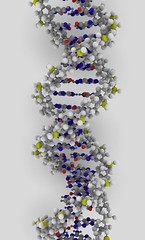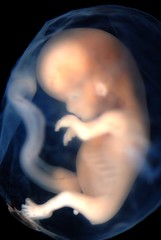| 5285067933 | Behavior genetics | The study of the relative power and limits of genetic and environmental influences on behavior |  | 0 |
| 5285067935 | environment | Every nongenetic influence, from prenatal nutrition to the people and things around us |  | 1 |
| 5285067937 | chromosomes | Threadlike structures made of DNA molecules that contain the genes |  | 2 |
| 5285067939 | DNA | A complex molecule containing the genetic information that makes up the chromosomes |  | 3 |
| 5285067941 | genes | The biochemical units of heredity that make up the chromosomes |  | 4 |
| 5285067944 | genome | The complete instructions for making an organism |  | 5 |
| 5285067947 | Identical twins | Twins who develop from a single fertilized egg that splits in two |  | 6 |
| 5285067950 | Fraternal twins | Twins who develop from separate fertilized eggs |  | 7 |
| 5285067953 | temperament | A person's characteristic emotional reactivity and intensity | 8 | |
| 5285067955 | heritability | proportion of variation among individuals that we can attribute to genes |  | 9 |
| 5285067959 | interaction | Occurs when the effect of one factor depends on another factor | 10 | |
| 5285067961 | Molecular genetics | Subfield of biology that studies the molecular structure and function of genes |  | 11 |
| 5285067963 | Evolutionary psychology | Study of the evolution of behavior and the mind using natural selection |  | 12 |
| 5285067965 | Natural selection | Principle that among range of inherited trait variations, those that lead to increased reproduction and survival will most likely be passed on to succeeding generations |  | 13 |
| 5285067967 | mutation | Random error in gene replication that leads to a change |  | 14 |
| 5285067969 | gender | Biologically and socially influenced characteristics by which people define male and female |  | 15 |
| 5285067971 | culture | The enduring behaviors, ideas, attitudes, values, and traditions shared by a group of people and transmitted from one generation to the next |  | 16 |
| 5285067973 | norm | An understood rule for accepted and expected behavior |  | 17 |
| 5285067976 | Personal space | The buffer zone we like to maintain around our bodies |  | 18 |
| 5285067978 | individualism | Giving priority to one's own goals over group goals and defining one's identity in terms of personal attributes rather than group identifications |  | 19 |
| 5285067980 | collectivism | Giving priority to the goals of one's group which often one's extended family or work group |  | 20 |
| 5285067984 | aggression | Physical or verbal behavior intended to hurt someone |  | 21 |
| 5285067986 | X chromosome | Sex chromosome found in both men and women | 22 | |
| 5285067989 | Y chromosome | Sex chromosome found only in males | 23 | |
| 5285067993 | testosterone | Most important of the male sex hormones |  | 24 |
| 5285067995 | role | Set of expectations about a social position |  | 25 |
| 5285067999 | Gender role | Set of expected behaviors for males and for females |  | 26 |
| 5285068001 | Gender identity | One's sense of being male or female |  | 27 |
| 5285068003 | Gender typing | Acquisition of a traditional masculine or feminine role |  | 28 |
| 5285068005 | Social learning theory | The theory that we learn social behavior by observing and imitating and by being rewarded or punished |  | 29 |
| 5285166417 | zygotes | The fertilized egg Enters a 2 week period of rapid cell division and develops into an embryo |  | 30 |
| 5285166418 | embryo | The developing human organism from about 2 weeks after fertilization through the 2nd month |  | 31 |
| 5285166422 | fetus | Developing human organism from 9 weeks after conception to birth |  | 32 |
| 5285166424 | teratogens | Agents, such as chemicals and viruses, that can reach the embryo or fetus during prenatal development and cause harm |  | 33 |
| 5285166426 | Fetal alcohol syndrome | Physical and cognitive abnormalities in children caused by a pregnant woman's heavy drinking |  | 34 |
| 5285166428 | Rooting reflex | Baby's tendency, when touched on the cheek, to turn toward the touch, open the mouth, and search for the nipple |  | 35 |
| 5285166430 | maturation | Biological growth process that enable orderly changes in behavior |  | 36 |
| 5285166432 | schemas | A concept or framework that organizes and interprets information |  | 37 |
| 5285166434 | assimilate | Interpreting one's new experience in terms of one's existing schemas |  | 38 |
| 5285166436 | accommodate | Adapting one's current understandings to incorporate new information |  | 39 |
| 5285166438 | cognition | All the mental activities associated with thinking, knowing, remembering, and communicating |  | 40 |
| 5285166440 | Sensorimotor stage | The stage during which infants know the world mostly in terms of their sensory impressions and motor activities in Piaget's theory from birth to about 2 years |  | 41 |
| 5285166444 | Preoperational stage | The stage during which a child learns to use language but does not yet comprehend the mental operations of concrete logic in Piaget's theory from about 2 to 6 or 7 years old |  | 42 |
| 5285166446 | conservation | The principle that properties such as mass, volume, and number remain the same despite changes in the forms of object |  | 43 |
| 5285166451 | Theory of mind | People's ideas about their own and others' mental states | 44 | |
| 5285166454 | Concrete operational stage | The stage of cognitive development during which children gain the mental operations that enable them to think logically about concrete events in Piaget's theory from 6 to 11 |  | 45 |
| 5285166456 | Formal operational stage | The stage of cognitive development during which people begin to think logically about abstract concepts in Piaget's theory beginning at the age of 12 |  | 46 |
| 5285166458 | Stranger anxiety | Fear of strangers that infants commonly display, beginning by about 8 months |  | 47 |
| 5285166460 | attachment | Emotional tie with another person, shown in young children by their seeking closeness to the caregiver and showing distress on separation | 48 | |
| 5285166462 | Critical period | Optimal period shortly after birth when an organism's exposure to certain stimuli or experiences produces proper development | 49 | |
| 5285166464 | imprinting | Process by which certain animals form attachments during a critical period very early in life |  | 50 |
| 5285166466 | Basic trust | According to Erik Erikson, a sense that the world is predictable and trustworthy, said to be formed during infancy by appropriate experiences with responsive caregivers |  | 51 |
| 5285166468 | self-concept | A sense of one's identity and personal worth |  | 52 |
| 5285166470 | adolescence | Transition period from childhood to adulthood, extending from puberty to independence |  | 53 |
| 5285166472 | puberty | Period of sexual maturation where a person becomes capable of reproducing | 54 | |
| 5285166474 | Primary sex characteristics | Body structures that make sexual reproduction possible | 55 | |
| 5285166476 | Secondary sex characteristics | Nonreproductive sexual characteristics | 56 | |
| 5285166478 | menarche | First menstrual period | 57 | |
| 5285166479 | Trust vs. mistrust | Erikerison's stage: Infancy (to 1) If needs are dependably met, infants develop a sense of basic trust | 58 | |
| 5285166484 | Autonomy vs. shame/doubt | Erikerison's stage: Toddlerhood (1-2) Toddlers learn to exercise will and do things for themselves, or they doubt their abilities | 59 | |
| 5285166487 | Initiative vs. guilt | Erikerison's stage: Preschooler (3-5) Preschoolers learn to initiate tasks and carry out plans, or they feel guilty about efforts to be independent | 60 | |
| 5285166490 | industry vs. inferiority | Erikerison's stage: Elementary (6-puberty) Children learn the pleasure of applying themselves to tasks, or they feel inferior | 61 | |
| 5285166493 | Identity vs. role confusion | Erikerison's stage: Adolescence (teens-20s) Teenagers work at refining a sense of self by testing roles and then integrating them to form a single identity, or they become confused about who they are | 62 | |
| 5285166496 | Intimacy vs. isolation | Erikerison's stage: Young adult (20s-40s) Young adults struggle to form close relationships and to gain the capacity for intimate love, or they feel socially isolated | 63 | |
| 5285166499 | Generativity vs. stagnation | Erikerison's stage: Middle adulthood (40s-60s) In middle age, people discover a sense of contributing to the world, usually through family and work, or they may feel a lack of purpose | 64 | |
| 5285166502 | Integrity vs. despair | Erikerison's stage: Late adulthood (60s+) When reflecting on his/her life, the older adult may feel a sense of satisfaction or failure | 65 | |
| 5285241306 | identity | One's sense of self Adolescent's task is to solidify a sense of self by testing and integrating various roles | 66 | |
| 5285241309 | intimacy | The ability to form close, loving relationships Primary development task in late adolescence and early adulthood | 67 | |
| 5285241312 | menopause | Time of natural cessation of menstruation | 68 | |
| 5285241314 | Alzheimer's disease | Progressive and irreversible brain disorder characterized by gradual deterioration of memory, reasoning, language, and physical functioning | 69 | |
| 5285241316 | Cross-sectional studies | Study where people of different ages are compared with one another | 70 | |
| 5285241318 | Longitudinal study | Research where same people are restudied and retested over a long period | 71 | |
| 5285241320 | Crystallized intelligence | One's accumulated knowledge and verbal skills Tend to increase with age | 72 | |
| 5285241323 | Fluid intelligence | One's ability to reason speedily and abstractly Tends to decrease during late adult | 73 | |
| 5285241326 | Social clock | Culturally preferred timing of social events such as marriage, parenthood, and retirement | 74 | |
| 5285241328 | Empty-nest syndrome | A feeling of distress focusing on a loss of purpose and relationship | 75 | |
| 5285262451 | nature versus nutrutre | extent to which heredity and the environment each influences behavior | 76 | |
| 5285266734 | continuity versus discontinuity | whether development is gradual, cumulative change from conception to death or a sequence of distinct stages | 77 | |
| 5285271574 | stability versus change | whether or not personality traits present during infancy endure throughout the life span | 78 | |
| 5285289379 | cohort-sequential study | cross-sectional groups are assessed at least two times over a span of months or years, rather than just once | 79 | |
| 5285299734 | prenatal development | begins with fertilizations or conception, and ends with birth | 80 | |
| 5285323007 | neonates | newborn babies | 81 | |
| 5285328367 | sucking | automatic response of drawing in anything at the mouth | 82 | |
| 5285330658 | swallowing | contraction of throat muscles that enables food to pass into the esophagus | 83 | |
| 5285334222 | grasping reflex | when the infant closes his or her fingers tightly around an object put in his or her hand | 84 | |
| 5285338140 | startle reflex | also called moro which a loud noise or sudden drop causes the neonate to automatically arch his/her limbs out, and quickly retract them | 85 | |
| 5285343662 | habituation | decreasing responsiveness with repeated presentation of the same stimulus | 86 | |
| 5285355528 | schema | mental representations that organize and categorize information processed by our brain | 87 | |
| 5285367587 | object permanence | that objects continue to exist even when out of signt | 88 | |
| 5285377012 | preoperational stage | language develops with the ability to think (2-7) | 89 | |
| 5285380596 | egocentric | seeing the world from his or her own point of view | 90 | |
| 5285383473 | animism | that all things living just like him or her | 91 | |
| 5285385615 | artificalism | all objects are made by people | 92 | |
| 5285413618 | internalization | absorbing information from a specified social enviornmental context | 93 | |
| 5285418870 | zone of proximal development | range between the level at which a child can solve a problem working alone with difficulty and the level at which a child can solve a problem with the assistance of adults or more-skilled children | 94 | |
| 5285437512 | preconventional | stage where they do the right thing to avoid punishment or to further their self-interests | 95 | |
| 5285446339 | conventional | stage where they follow rules to live up to the expectations of others or to maintain the law and order and do their duty | 96 | |
| 5285452352 | postconventional | stage where they evidence a social contract orientation that promotes the society's welfare or evidence an ethical principle orientation that promotes justice and avoids self- condemnation | 97 | |
| 5285459015 | social development | influence of others on the development of a person | 98 | |
| 5285465025 | self-awareness | consciousness of oneself as a person | 99 | |
| 5285467361 | social referenceing | observing the behavior of others in social situations to obtain information or guidance | 100 | |
| 5285471789 | authoritarian parents | set up strict rules, expect children to follow them, and punish wrongdoing | 101 | |
| 5285475713 | authoritative parents | set limits but explain the reasons for rules with their children and make exceptions when appropriate | 102 | |
| 5285479316 | permissive parents | tend not to set firm guidelines if they set any at all. more responsive than demanding | 103 | |
| 5285484074 | uninvolved parents | few demands, show low responsiveness and communicate little with their children | 104 | |
| 5285494825 | biological persepective | difference between the sexes to heredity | 105 | |
| 5285496749 | evolutionary perspective | perscpective that focuses on our behavioral tendencies to prepare us to survive and reproduce | 106 | |
| 5285500194 | psychoanalytic persepctive | the perspective that focuses on how young girls learn to act feminine from their mothers, and young boys learn to act masculine from their fathers | 107 | |
| 5285503816 | cognitive perspective | children actively engage in making meaning out of information they learn about gender | 108 | |
| 5285507834 | gender role stereotypes | broad categories that reflect our impressions and beliefs about males and females | 109 | |
| 5285511141 | androgyny | presence of desirable masculine and feminine characteristics in the same individual | 110 | |
| 5285514812 | stereotype threat | anxiety that influences members of a group concerned that their performance will confirm a negative sterotype | 111 |
AP psych: Developmental psychology Flashcards
Primary tabs
Need Help?
We hope your visit has been a productive one. If you're having any problems, or would like to give some feedback, we'd love to hear from you.
For general help, questions, and suggestions, try our dedicated support forums.
If you need to contact the Course-Notes.Org web experience team, please use our contact form.
Need Notes?
While we strive to provide the most comprehensive notes for as many high school textbooks as possible, there are certainly going to be some that we miss. Drop us a note and let us know which textbooks you need. Be sure to include which edition of the textbook you are using! If we see enough demand, we'll do whatever we can to get those notes up on the site for you!

